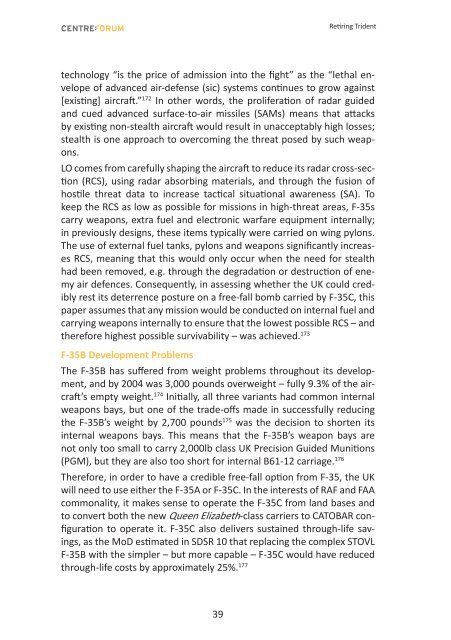Retiring Trident
retiring-trident
retiring-trident
You also want an ePaper? Increase the reach of your titles
YUMPU automatically turns print PDFs into web optimized ePapers that Google loves.
<strong>Retiring</strong> <strong>Trident</strong><br />
technology “is the price of admission into the fight” as the “lethal envelope<br />
of advanced air-defense (sic) systems continues to grow against<br />
[existing] aircraft.” 172 In other words, the proliferation of radar guided<br />
and cued advanced surface-to-air missiles (SAMs) means that attacks<br />
by existing non-stealth aircraft would result in unacceptably high losses;<br />
stealth is one approach to overcoming the threat posed by such weapons.<br />
LO comes from carefully shaping the aircraft to reduce its radar cross-section<br />
(RCS), using radar absorbing materials, and through the fusion of<br />
hostile threat data to increase tactical situational awareness (SA). To<br />
keep the RCS as low as possible for missions in high-threat areas, F-35s<br />
carry weapons, extra fuel and electronic warfare equipment internally;<br />
in previously designs, these items typically were carried on wing pylons.<br />
The use of external fuel tanks, pylons and weapons significantly increases<br />
RCS, meaning that this would only occur when the need for stealth<br />
had been removed, e.g. through the degradation or destruction of enemy<br />
air defences. Consequently, in assessing whether the UK could credibly<br />
rest its deterrence posture on a free-fall bomb carried by F-35C, this<br />
paper assumes that any mission would be conducted on internal fuel and<br />
carrying weapons internally to ensure that the lowest possible RCS – and<br />
therefore highest possible survivability – was achieved. 173<br />
F-35B Development Problems<br />
The F-35B has suffered from weight problems throughout its development,<br />
and by 2004 was 3,000 pounds overweight – fully 9.3% of the aircraft’s<br />
empty weight. 174 Initially, all three variants had common internal<br />
weapons bays, but one of the trade-offs made in successfully reducing<br />
the F-35B’s weight by 2,700 pounds 175 was the decision to shorten its<br />
internal weapons bays. This means that the F-35B’s weapon bays are<br />
not only too small to carry 2,000lb class UK Precision Guided Munitions<br />
(PGM), but they are also too short for internal B61-12 carriage. 176<br />
Therefore, in order to have a credible free-fall option from F-35, the UK<br />
will need to use either the F-35A or F-35C. In the interests of RAF and FAA<br />
commonality, it makes sense to operate the F-35C from land bases and<br />
to convert both the new Queen Elizabeth-class carriers to CATOBAR configuration<br />
to operate it. F-35C also delivers sustained through-life savings,<br />
as the MoD estimated in SDSR 10 that replacing the complex STOVL<br />
F-35B with the simpler – but more capable – F-35C would have reduced<br />
through-life costs by approximately 25%. 177<br />
39




